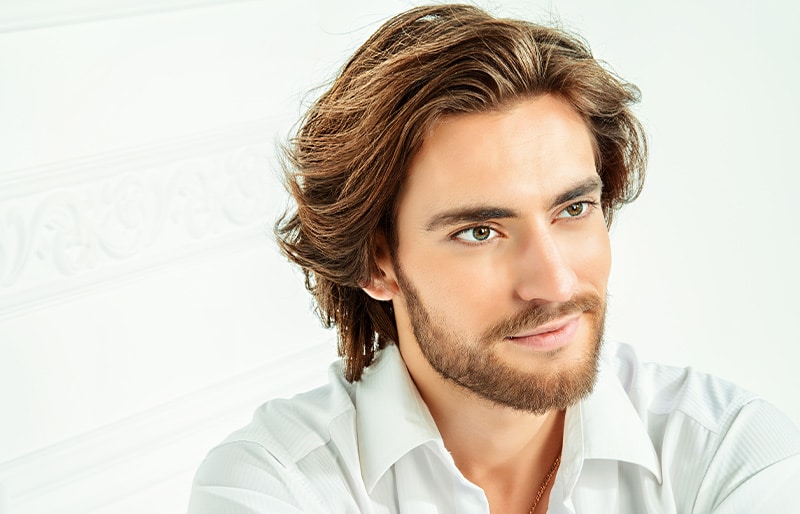Millions of people are dealing with hair loss. If you’re one of them, you might be surprised to learn that your own blood can help to reverse it. Platelet-rich plasma (PRP) therapy is a non-surgical hair restoration procedure that uses the platelets found in your blood to stimulate hair growth. Dr. Louis DeJoseph offers PRP therapy, along with other hair restoration techniques at his practice in Atlanta, Georgia. Learn more about what it involves and if it’s right for you.

- What Is Platelet-Rich Plasma?
- What Does Platelet-Rich Plasma Treat?
- How Does PRP Work?
- PRP Hair Restoration Candidates
- The PRP Consultation Process in Atlanta
- What Happens During PRP Hair Loss Treatment
- What to Expect After PRP treatment
- Risks and Side Effects of PRP Hair Loss Therapy
- PRP for Hair Loss FAQS

What Is Platelet-Rich Plasma?
Plasma is a part of the blood that contains platelets that encourage clotting as well as proteins that stimulate cell growth. It’s possible to separate plasma from the blood and concentrate it, creating platelet-rich plasma, or PRP.
To produce PRP, Dr. Louis DeJoseph will first take a sample of your blood. He’ll then run the blood through a centrifuge so that the red blood cells separate from the plasma and platelets. The separated PRP is then prepared for injection into the patient.

What Does Platelet-Rich Plasma Treat?
One of the original uses of PRP therapy was to treat injuries of the joints and tendons, usually experienced by athletes. PRP therapy is also used to help rejuvenate the skin, as part of what’s sometimes called a “vampire facelift®.”
Another use of PRP is to promote hair growth and reverse hair loss. PRP therapy can be effective at slowing down hair loss caused by pattern baldness, stress, tight hairstyles, and nutritional deficiencies. It’s usually recommended for people who are in the early stages of hair loss rather than for people who have large bald spots or large areas of thinning hair.
How Does PRP Work?
PRP therapy uses your own blood to encourage the growth of new hair. Every strand on your head moves through three phases from the time it emerges until it falls out. The first phase is the anagen, or active growth phase. The anagen phase can last anywhere from a couple of years to seven years, depending on the person.
After the anagen phase, hair moves into the transition phase, called catagen. Compared to anagen, catagen is short and lasts just under two weeks. The third stage is telogen or the resting phase. Telogen is the last phase before the hair is shed. It usually lasts a few months.
It’s thought that the PRP injected into the scalp extends the length of the growing phase of hair. When hair grows for a longer period, it has more of a chance to appear thick and full.
Another way to describe how PRP therapy works for hair loss is to say that it “wakes up” sleeping hair follicles. Hair follicles that have become inactive as a result of a multitude of factors can be stimulated by the proteins and growth factors found in PRP.
PRP Hair Restoration Candidates
The ideal candidate for PRP therapy for hair loss is someone who is just beginning to see signs of hair thinning or loss. Usually, a person will have begun to notice thinning hair within the past few years. It can be more challenging for the PRP to restore or “wake up” hair follicles that have been inactive for many years.
PRP can be an effective hair restoration treatment for a variety of different types of hair loss, including male or female pattern baldness, traction alopecia, hair loss caused by stress, and hair loss that occurred as a result of a side effect medication, or nutritional issues.
While many people with hair loss in the early stages can benefit from PRP therapy, there are some for whom the therapy might not be right. If you are on a blood thinner, you might not get the results you hoped for, as your platelets won’t be able to act in the same way. Hair loss that is a result of a chronic medical condition such as lupus also isn’t likely to respond to PRP therapy.
The PRP Consultation Process in Atlanta
During a PRP Hair Treatment consultation, you’ll meet with an experienced specialist to discuss your hair restoration goals. The process begins with a detailed scalp assessment to determine the health of your hair follicles and suitability for PRP therapy. Your medical history, lifestyle, and expectations are reviewed to create a personalized treatment plan. The specialist will explain how PRP uses your body’s natural growth factors to stimulate hair regrowth and improve hair thickness. You’ll also learn about the procedure, expected results, and potential timelines.
What Happens During PRP Hair Loss Treatment
PRP therapy is a non-surgical, three-part process performed in our clinic and takes 15 – 20 minutes. During the first step of the process, Dr. Louis DeJoseph will take a sample of your blood. The sample will then be placed in a centrifuge. The machine will spin fast enough to separate the platelet-rich plasma from the red blood cells and from platelet-poor plasma.
Dr. Louis DeJoseph will then place the PRP into a syringe and inject it into the scalp. He’ll focus on injecting the areas of the scalp that are experiencing hair loss. After the injections are finished, the scalp will be cleaned and the treatment over.
What to Expect After PRP treatment
Since PRP therapy isn’t surgery, there’s very little downtime required afterward. Your scalp might be tender and swollen for a few days after the treatment, but you’ll most likely be able to go to work or do other regular activities. If you feel any discomfort, take Tylenol rather than ibuprofen or aspirin during those first few days. NSAIDs like aspirin can thin the blood and potentially affect your results.
It can take some time before you see a noticeable improvement in your hair loss after PRP therapy. Individual results will vary but you can generally expect to notice an improvement within three to six months after your first treatment.
It’s usually a good idea to schedule multiple therapy sessions, spaced about a month apart. Your first three sessions can be one month apart, then your fourth session can be six months later. Many people decide to undergo PRP therapy on an annual or semi-annual basis to maintain their results.
Risks and Side Effects of PRP Hair Loss Therapy
PRP therapy has few side effects and risks. Some of the potential side effects of the treatment include discomfort at the sites of the injections and infection. There is also the risk of nerve damage as a result of the injection, but working with a board-certified and experienced facial plastic and hair restoration surgeon significantly reduces that risk.
Patient Reviews
Why Visit Premier Image Cosmetic and Laser Surgery for PRP Therapy?
Dr. Louis DeJoseph is a triple board-certified plastic surgeon who offers PRP therapy and other hair restoration options at Premier Image Cosmetic and Laser Surgery in Atlanta, Georgia. Dr. Louis DeJoseph has helped countless patients, both women and men, get their hair and their confidence back through FUT hair transplants. He’s now doing the same with PRP therapy.